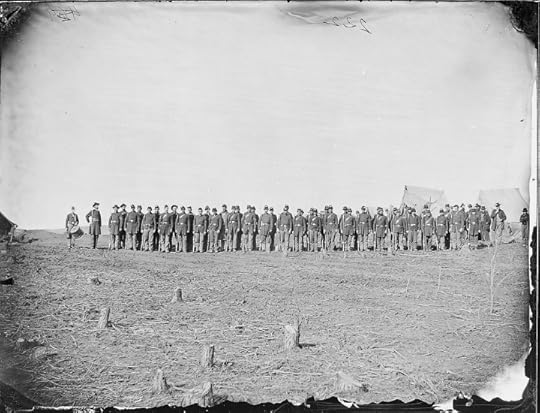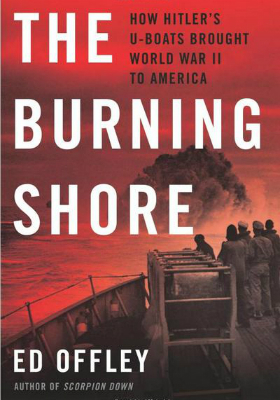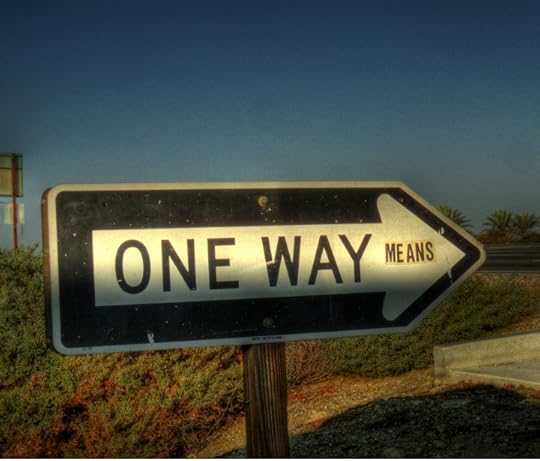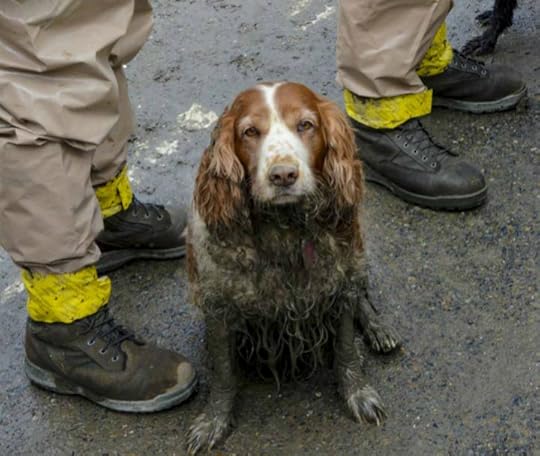Thomas E. Ricks's Blog, page 51
April 8, 2014
Has the CIA been committing civil disobedience? If so, it’s time to man up

A letter I wrote to the editor of the Washington Post ran in this morning's editions. Here it is:
As I
read Jose A. Rodriguez's defense of his actions ["I ran the CIA interrogation program. Whatever
the Senate report says, I know it worked," Outlook, April 6], and having listened to people I know
in the intelligence agencies discuss their actions over the past 12 years, I
picked up an aggrieved tone: We did what we had to do. This applies to the use
of torture in interrogations (because hanging people from walls, beating their
heads into walls and pouring ice water up their upturned noses is just that)
and to a variety of intrusions on our constitutional rights.
That
is, many of these people know they went over the line. I've actually had people
tell me that the CIA has learned its lesson and won't do it again. But they add
that hard times warranted hard measures.
This
argument, plus the agency's relations with Congress, seem to amount to civil
disobedience. That is, these people believed that the laws were wrong and that,
as patriots, they were compelled to obey a higher duty. There is a long and
honored tradition of such actions in this country. The difference is that
Martin Luther King Jr. and others were willing
to go to jail for their civil disobedience.
So,
CIA and National Security Agency officials, I think the honorable course would
be to stand up and say: "These were the things we did. We thought them
necessary at the time. We still do. But we understand we broke the law and are
willing to accept the consequences of our actions, for which we remain proud.
We throw ourselves upon your mercy."
Sherman (V) explains generalship and the distinct roles of regiments and companies

More to celebrate
Confederate Defeat Month from General Sherman:
"The company is the
true unit of discipline, and the captain is the company."
"The regiment is the
family.... In war the regiment should never be subdivided, but should always be
maintained entire."
"No general can
accomplish the full work of his army unless he commands the soul of his men, as
well as their bodies and legs."
'The Burning Shore': An account of submarine warfare along the east coast

The Best
Defense mailboat, MV George C. Marshall,
managed to evade any U-boats lurking below the North Atlantic ice floes and
then steamed into my little harbor. A burly deckhand
hurled to the dock a new book that looks to be fun, Ed Offley's The
Burning Shore: How Hitler's U-Boats Brought World War II to America. This is a subject that we don't
talk about much, that early phase of the war when Americans could see their
ships burning just offshore, so I am glad that Ed turned to it. I haven't yet
read it, but I remember reading a good mystery novel about the subject, Something
in the Water.
April 7, 2014
11 years after: Fighting in Yousifiya as the 'Triangle of Death' heats up once more

It's the 11th
anniversary of U.S. forces entering Baghdad. What's
happening? Same ol' same ol', just south
of Baghdad, last Friday. I remember having lunch down
there with an Iraqi commander and his advisor when a rocket or mortar shell hit
outside. I asked, "What was that?" -- meaning which type of weapon. The
American officer responded, "That was the losing contractor" (on the
construction project next door).
Bad
things also happened on Sunday in another of "the 'iyahs,"
as American troops called this group of towns, AKA "the Triangle of Death."
What's more, Baghdad
airport has been rocketed and mortared lately, provoking
the U.S. government to issue a travel warning. So you might want to reconsider
spending Easter break swimming in the Tigris.
Meanwhile, the Florida legislature expanded
"stand your ground" by approving "warning
shots." Oh, great.
10 years after: Fighting in Yousifiya as the 'Triangle of Death' heats up once more

It's the 10th
anniversary of U.S. forces entering Baghdad. What's
happening? Same ol' same ol', just south
of Baghdad, last Friday. I remember having lunch down
there with an Iraqi commander and his advisor when a rocket or mortar shell hit
outside. I asked, "What was that?" -- meaning which type of weapon. The
American officer responded, "That was the losing contractor" (on the
construction project next door).
Bad
things also happened on Sunday in another of "the 'iyahs,"
as American troops called this group of towns, AKA "the Triangle of Death."
What's more, Baghdad
airport has been rocketed and mortared lately, provoking
the U.S. government to issue a travel warning. So you might want to reconsider
spending Easter break swimming in the Tigris.
Meanwhile, the Florida legislature expanded
"stand your ground" by approving "warning
shots." Oh, great.
Counterdrone ops suddenly all the rage

On
the heels of the Future of War essay the other day by
Capt. Adam Thomas about the growing importance of counterdrone operations, Jane's Defence Weekly steps up and reports the Israelis are
working this area, too. They find that defending against drones involves mainly
dealing differently because of two issues -- the small radar signature and the
slowness of the li'l planes.
A
friend points out that the most significant use of drones in the future might
be swarms of hundreds to saturate the enemy's defenses. Many would carry
weapons, but many more would just be there as targets -- but he would have to
try to knock them all down. Then, after the enemy has expended a lot of time,
energy, and bullets on the drones, you send in your piloted bombers and
fighters.
Marshall and Lejeune: The respect two great generals had for each other

I
tell the tale in the new issue of
the Marine Corps Gazette. Basically,
Lejeune kept on trying to hire Marshall for a top position at VMI.
April 4, 2014
General Sherman (IV) says one sign of effective leadership is having a small staff

More Sherman stuff to continue our celebration of Confederate Defeat Month:
A bulky staff
implies a division of responsibility, slowness of action, and indecision,
whereas a small staff implies activity and concentration of purpose. The
smallness of General Grant's staff throughout the civil war forms the best
model for future imitation.
In addition, staffs
should not live better than the troops. "Officers should never seek for houses,
but share the condition of their men."
What bothers me about the making of strategy through 'ways, means, and ends'

I was thinking
about the "ways, ends, means" strategic formulation recently, because
it long has seemed to me to be insufficient. I suspect that "ways, ends,
means" leaves out a key aspect of warfare -- the spiritual aspect. This is
not just a matter of faith or morale, but is a key aspect of warfare, because
it goes to the question of will.
So,
I am beginning to think that "ways, ends, means" doesn't work for me
because it pretends to be a scientific approach. But there is a reason that
Clausewitz referred to "the art of war."
This
is why I prefer the formulation of strategy as another three questions -- much
broader ones: "Who are we, what are we trying to do, and how are we going to do
it?"
I
asked the estimable Chris Mewett about this, and he wrote back:
I think the
ends/ways/means construct is just another way of approaching the same set of
questions you've posed. The intent of both is to require thought: to force the would-be strategist to consider
whether the tools he has at his disposal can offer a reasonable chance of
accomplishing the desired objectives.
"The spiritual
aspect" and matters of will are only left unconsidered if the would-be
strategist ignores how those factors inhere in the very nature of war. If we
recognize that war's nature is violent, emotional, and uncertain -- if we
acknowledge that the basic means of war is fighting, from which all of these
tendencies/conditions are inseparable -- then how can we say that the
ends/ways/means construct fail to take account of moral factors?
This is exactly why I think the debate about war's enduring
nature is important. War is a different phenomenon from not-war. It operates
according to the influence of those tendencies that are essential to its
nature: instinctive passions born of violence; chance and uncertainty; and its
subordination as an instrument of policy. (In Clausewitz's memorable phrasing,
war has its own grammar, but not its own logic.)
Excluding the moral, the "spiritual," and the will can only happen
when we lose touch with this uniqueness and imagine that the violent means of
war function in precisely the same way as the non-violent means of other forms
of political intercourse. This isn't a flaw in the ends/ways/means construct
but in the way we understand what war is.
Rebecca's War Dog of the Week: Dog teams search the wreckage of Washington's mudslide

By Rebecca Frankel
Best Defense Chief Canine Correspondent
Dogs have been on the scene of the March 22 mudslide in Oso,
Washington, that's so far claimed 30
people, a count that is likely only to rise as a number of people are still
missing.
The conditions caused by the mudslide have been particularly
difficult, posing challenges for the dogs' powerful sense of smell and the way
they track odor. As one veteran handler on the scene told
National Geographic, "there is so much debris, everything is torn
apart, and the human scent can be really spread around.... Plus, it's been
raining and cold -- one dog ended up with hypothermia from working in the
water."
Despite the difficult terrain, more search and rescue dog
teams have even been called in from other states -- like California
and Utah
-- to help with the search. These include dogs like the one pictured above, who sits at the
feet of Washington National Guardsmen to be washed after working the debris
field created by the mudslide, and Cody, pictured below with her handler Lisa
Bishop from Northwest Disaster Search Dogs. The pair is looking up to watch a
Washington National Guard helicopter circle overhead.
Some of the photos
of the search and rescue dogs in Washington show them as beleaguered and worn
as their exhausted human counterparts. And the dogs can only search for so long
before they get worn out and their efforts becomes
ineffective. (One of the best photo series on search and rescue dogs is
this New York Times collection: "The
Search and Rescue Dogs from 9-11".)
War-dog
history is flush with legions of dogs who located the wounded (or the
fallen) on the battlefield, and the U.S. military has employed
search and rescue dogs in recent years, adding them to their ranks. In many
ways, we're most accustomed now to using dogs to prevent tragedy -- to
save lives. But sadly, when the occasion calls, we also bring in dogs for recovery
-- to lead with their noses and do what humans and technology still cannot do
better without them.
Thomas E. Ricks's Blog
- Thomas E. Ricks's profile
- 437 followers




